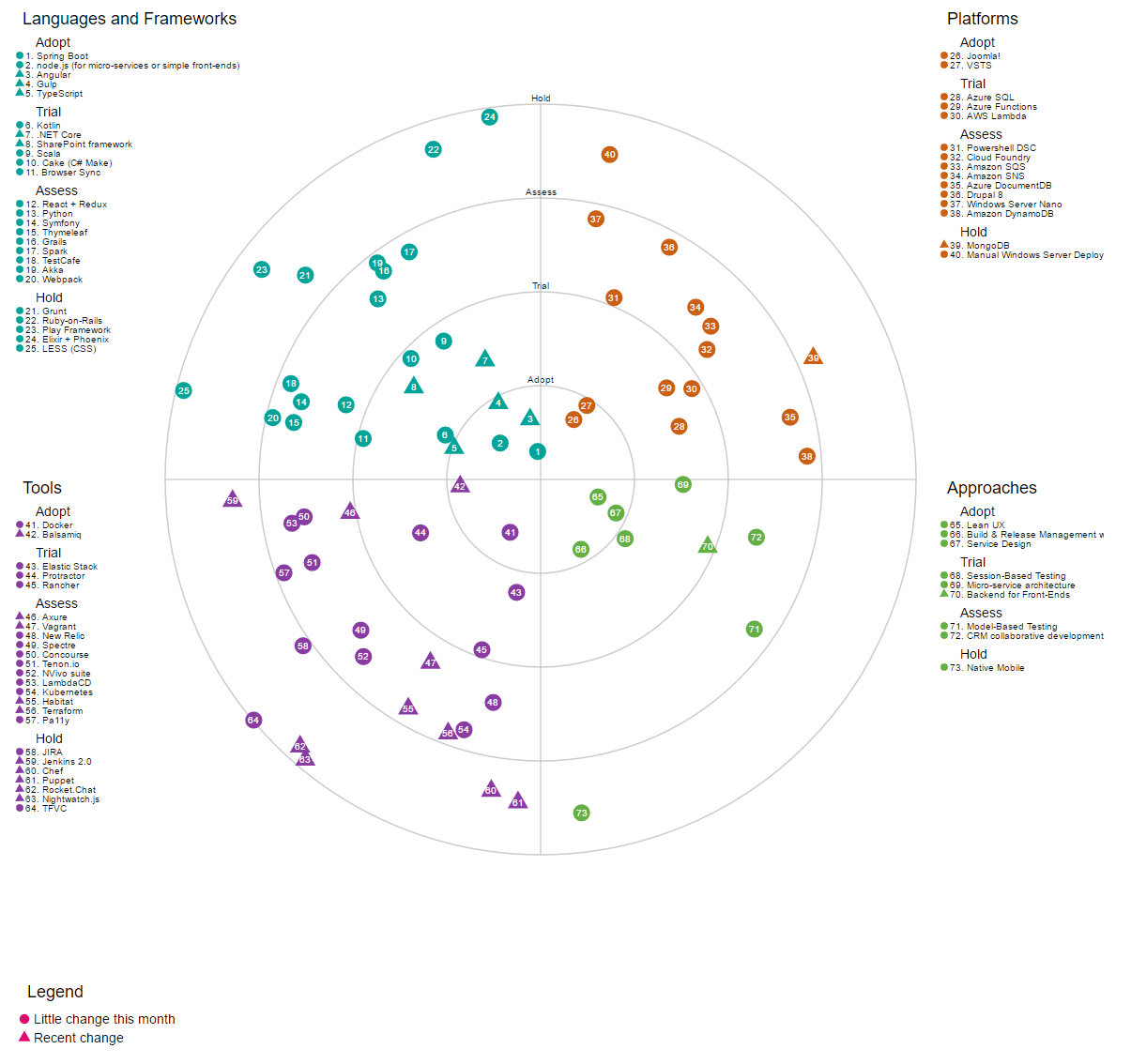New home for the TechRadar!
Introduction
This month the TechRadar reports have a more accessible home. From now on, no more PDF trees will be chopped down as the reports will now be available from this blog. This is all open source, so if you would like to contribute (particularly if you’d like to help improve the theming of this site) - the source can be found here.
Progress this month
You’ve all been very busy this month on project work, so slightly slimmer report than previous months. However we still have been building momentum on our initiatives, and also these are now starting to bear fruit. Just this month we have kicked off a new project with MOD where we will take advantage of our learnings around Angular2 for the front-end of their Single Page Application, as well as VSTS’ Release Management for Continuous Delivery through to an Azure UAT instance continuously configured using ARM templates. Further, we’re working on a Discovery phase with the Home Office at the moment where the solution may likely be developed in Kotlin. Give me a shout if you’re interested in these technologies but not sure where to start.
You’ll also notice that there are less blips on the radar this month. Ultimately, the TechRadar should reflect reality behind the key things that are on our radar at the moment. This may mean that from time to time we will retire things from the radar that have not featured for a couple of months. In order to not lose out on some of our findings, you can find the archived items within this site.
Backend & Modern Architectures
Following on from last month’s JVM dojo, we’ve continuing to progress our understanding of languages like Kotlin - we’re building APIs to retrieve data and statistics from the various internal tools that we have - like TFS, VSTS and Yammer. We’ve been talking about Serverless approaches on Yammer - effectively this is the movement of splitting up applications to maximise the effectiveness of individual components, taking advantage of cheaper and more efficient ways to run (eg using PaaS techniques such as Azure App Services, or ‘PAYG’ PaaS techniques like Azure Functions or AWS Lambda). We’ve started using some PaaS techniques with our CRM projects and we’re increasingly seeing demand for experience of PaaS approaches in bids. As this will undoubtedly have a big influence on the pricing structure for our proposals getting a good handle on these will give us a strong edge in winning work.
Front-end
As mentioned above, we have a great opportunity to put a lot of the new technologies we’ve been trialing to practice with the MOD. We’re using:
- TypeScript with Angular 2
- WebPack and Browser Sync for rapid prototyping
- Protractor.js for testing
- VSTS for coordinating the build and release pipeline to Azure
If you’d like to know more then speak to Richard G. Press, Matt George, Dhirajsinh Rajeshirke, Nayan Mer or Jimmy Mecwan. This is a great opportunity for us to branch out and learn from experiencing a different ecosystem. We frequently see opportunities for working with Angular, however it can be difficult when in a catch-22 situation of not having experience to win the work that would give us experience. JavaScript frameworks are unlikely to feature in every project we do here as it can be a challenge using them when sites need to be fully accessible and GDS compliant, however they do provide an elegant way for developing Single Page Applications avoiding vendor-lock in as when using ASP.NET currently.
Likewise the new SharePoint framework also has support for JavaScript front-end frameworks, and saw a good demo from Sam Goodey using React and TypeScript to develop a simple SharePoint form, you can find the code to this on our GitHub account here and here.
DevOps
We’ve begun the long road towards DevOps as an organisation this month. We’ve started getting together to plan our attack to prepare ourselves for much more rapid feedback. Whilst DevOps does involve significant technological change, it does involve more about change in how we work, the interactions that we have, how we organise ourselves, and adapting processes to enable people to work together faster in a more collaborative way. Don’t expect rapid progress on this, but do expect to be challenged upon the way that we work, and embrace being open to trying new approaches. Undoubtedly there will be hiccups along the way, but working in an ever more rapid and agile way has to be our goal to stay relevant in this marketplace.
From a technological perspective, aligning ourselves with GDS would be a sensible approach on this. This post provides a good insight into what technologies and approaches GDS use to orchestrate their deployments. A number of the new technologies on the radar this month (eg. Terraform have fallen out of this initiative.
User Centred Design
Unfortunately this month we say goodbye to our Senior User Researcher, Angela Boodoo, who will be leaving SFW later this month. Angela has done a great job in promoting the value of User Research and approaches of better discovering user needs to us all at SFW and will be missed. As a cloning machine has yet to make it’s way to the Adopt ring on the radar a search for her replacement has begun. We wish her well for her future endeavours!
Snapshot of the radar
